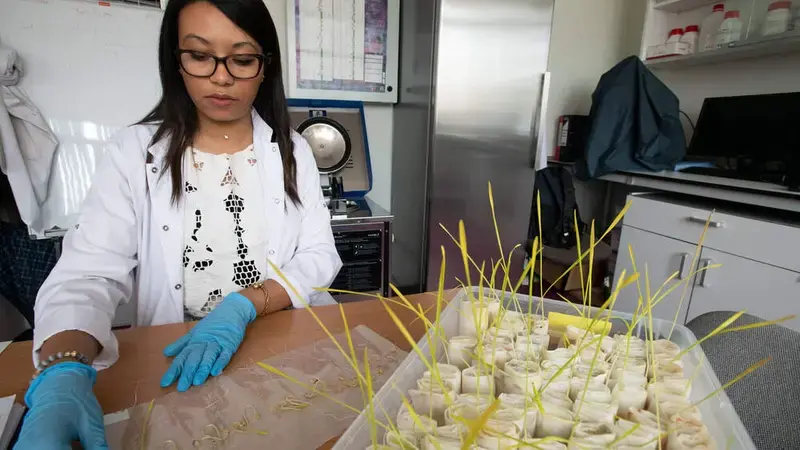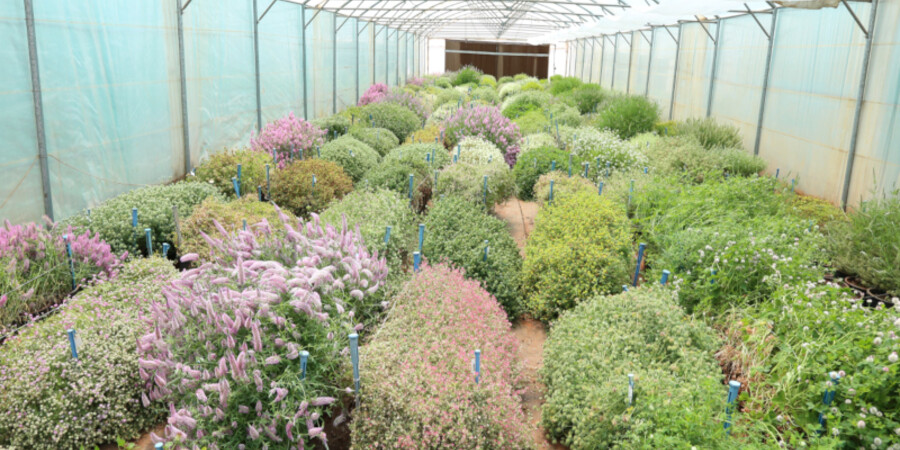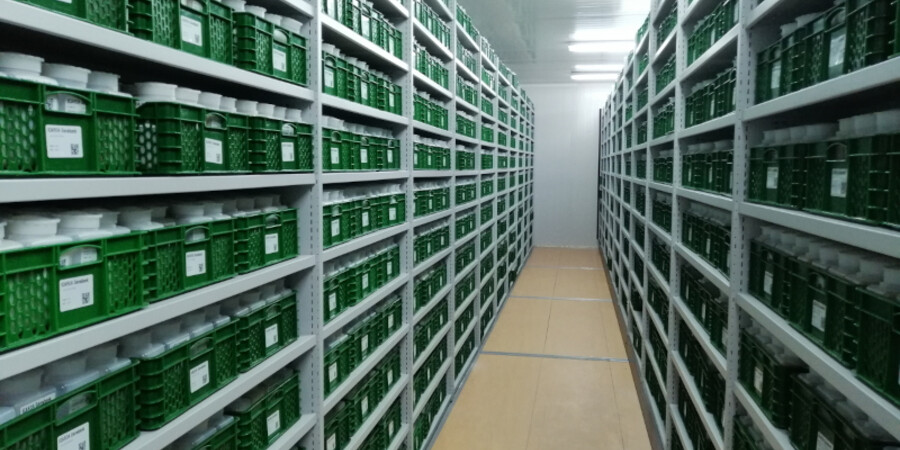ICARDA genebank: collecting, conserving, and using dryland agrobiodiversity

- Zakaria Kehel - Genetic Resources, conservation, characterization, and use (GRS) Research Team Leader
ICARDA’s Genebank works alongside global networks to collect, conserve, and promote for use vital genetic resources, focusing on agrobiodiversity protection in dry regions.
Agro-biodiversity supports the livelihoods of millions of people living within rural communities throughout the globe. It is a vital component for global food security and stability amid the challenges presented by climate change, diminishing natural resources, and a rapidly growing population.
ICARDA’s Genebank was established in 1985 in Tel Hadiya, Syria. It contains around 152,224 accessions of major winter cereals, food legumes, forage, and rangeland species drawn from four major Centers of Origin of the Crops – including the ‘Fertile Crescent’ in Western Asia, the Abyssinian highlands in Ethiopia, and the Nile Valley, where the earliest known crop domestication practices were first recorded.
ICARDA’s Collection ranks among the most important worldwide. The Collection comprises mostly landraces and wild relative species that are vital for developing new crops by breeding for traits that can cope with ever more harsh conditions driven by climate change. More than 85% of the accessions are characterized (studied for their different traits and advantages), and 75% are georeferenced (important to develop new crops for use in similar settings).
ICARDA's Genebank also contributes to the development of new open-access tools for electronic data capture, data analysis, and decision support – thereby making data on genetic resources and bioinformatics more widely available. Furthermore, it provides pioneering approaches for the assessment of the status and threats of agro-biodiversity in the dry areas, recommending proper management plans for ensuring sustainability.
Impact
On average, up to 15,000 accessions are regenerated, characterized and evaluated annually, for unique adaptive-specific traits.
One of the key tasks of ICARDA's Genebank is to respond to requests for accessions to ensure a continuum between the conservation and utilization of genetic resources. ICARDA distributes around 6,000 samples every year for research, breeding and educational purposes by the research community and academia and for direct use by farmers.
All information gathered from the acquisition, regeneration, characterization, storage, and distribution is documented in the ICARDA Genebank database, available to the Genebank staff through the web-based documentation system. The passport data are available to public users through the FIGS application, the ICARDA Seed Request System and the global platform GENESYS.
The Genebank provides training to young scientists involved in genetic resource conservation. It organizes at least one course every year, covering topics such as best practices for ex-situ conservation, documentation, information management, policy and legislation, sustainability, and the use of GIS and remote-sensing tools to assess agro-biodiversity and land use.
ICARDA’s Genebank
- Enriches existing collections with novel diversity using gap analysis.
- Applies best practices for regeneration, characterization, ex-situ conservation, documentation and distribution of seed and rhizobium genetic resources.
- Develops approaches for efficient mining of genetic resources using the ‘FIGS’ – or Focused Identification of Germplasm Strategy – approach.
- Contributes to the use of genetic resources, mainly through strengthening pre-breeding efforts.
- Provides training and technical support on all aspects related to the conservation and sustainable use of dryland agro-biodiversity, and related policies and legislation.
Contributes to building a global system for the conservation of genetic resources, and enhances regional networking.
Databases and Tools
- Seed Request System: a platform that allows users to explore the Genebank collection and submit requests for material. The platform also enables users to track the progress of their requests.
- FIGS application: an application that allows extracting passport data of the genetic resources from the Genebank database and performing a.o. filtering, clustering, and PCA analysis based on climate variables. The code for the application is available in the shinyFIGS GitHub repository.
- icardaFIGSr: an R package available on CRAN that runs the Focused Identification of the Germplasm Strategy (FIGS) to make best subsets from the Genebank Collection.
- Genesys: a global portal for plant genetic resources for food and agriculture. Germplasm accessions from genebanks around the world can be found and ordered here.
Core Genebank Activities
1. Collection and acquisition
In collaboration with its national and international partners, ICARDA’s Genebank has conducted over 230 collecting missions in 41 countries. The collecting missions are based on gap analyses to cover the distribution areas of different species, or to target specific adaptive traits, adding novel diversity to the collection.
ICARDA also receives accessions from other gene banks and donors around the world. It receives genetic stocks and elite breeding germplasm with known valuable traits from breeders and researchers. All of these acquisitions are done using the FAO Germplasm Acquisition Agreement or the Standard Material Transfer Agreement of the ITPGRFA.

2. Regeneration and characterization
Good quality seeds, with high viability and no quarantine diseases, must be produced prior to conservation. The accessions are planted in fields, greenhouses, or isolation cages using the best techniques to ensure the conservation of genetic integrity.
During regeneration, the accessions are characterized using major descriptors and, in some cases, molecular techniques. On average, up to 15,000 accessions are regenerated and characterized annually with the ultimate purpose of mining for specific adaptive traits.

3. Storage and conservation
Once threshed, cleaned, and fumigated, seeds are transported from fields to the Genebank facilities, where they spend 6-8 weeks in drying rooms (15 °C and 15% humidity) before being processed and conserved. They are also subjected to viability and seed health testing.
The seeds are stored under two types of conditions. For long-term storage (base collection), the seeds are kept in vacuum-sealed aluminum-foil bags at -20 °C. For medium-term storage (active collection), the seeds are put in tightly closed plastic jars and kept at 2-4 °C and a relative humidity of less than 25 percent. Seeds in active collection are the ones available for distribution upon request. Two additional samples are packed in air-vacuumed aluminum foils and sent for long-term conservation as safety duplicates, one to reliable gene banks, and the other to the Svalbard Global Seed Vault.

4. Distribution
One of the key tasks of ICARDA's gene bank is to respond to requests for accessions to ensure continuum between the conservation and utilization of genetic resources. In the past, ICARDA distributed 6,000 samples every year. Since 2010, ICARDA has adopted the Focused Identification of Germplasm Strategy (FIGS) approach to better respond to requests, allowing for the more efficient mining of the Genebank holdings using fewer accessions.
FIGS is based on the relationship between the environmental layers and the trait sought. Using sophisticated models and algorithms, it identifies accessions that are most likely to contain traits that can solve a particular breeding challenge, such as tolerance to heat or resistance to a specific disease.

5. Documentation
All information gathered from the acquisition, regeneration, characterization, storage, and distribution is documented in the ICARDA Genebank database. This information is available to the Genebank staff through the web-based documentation system. The passport data are available to public users through the FIGS application, the ICARDA Seed Request System and through the global platform GENESYS.
6. Training and promotion
The Genebank provides training to young scientists involved in genetic resources conservation. It organizes at least one course every year, covering topics such as best practices for ex situ conservation, documentation, information management, policy and legislation, sustainability, and the use of GIS and remote-sensing tools to assess agro-biodiversity and land use.
ICARDA actively works to raise public awareness about the importance of conserving and using genetic resources. Researchers attend international conferences to discuss the need for policies and legislation to improve global food security.
